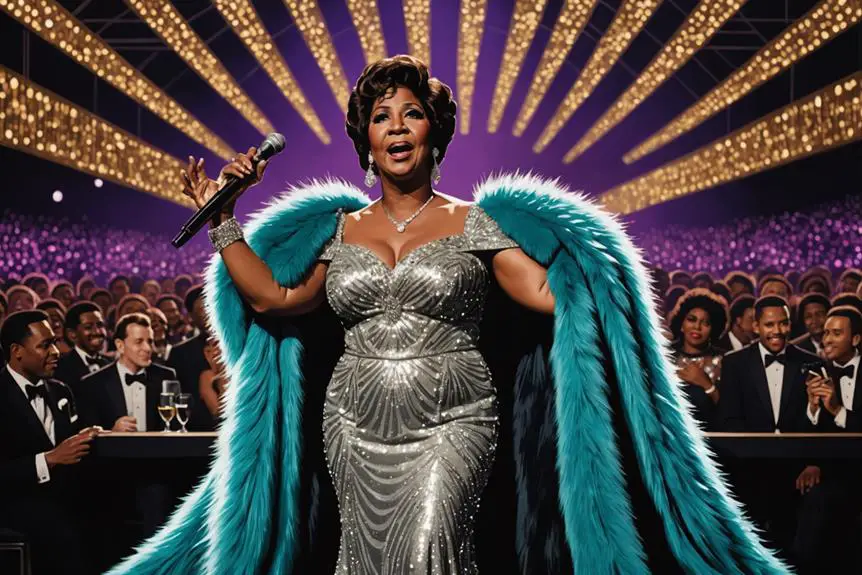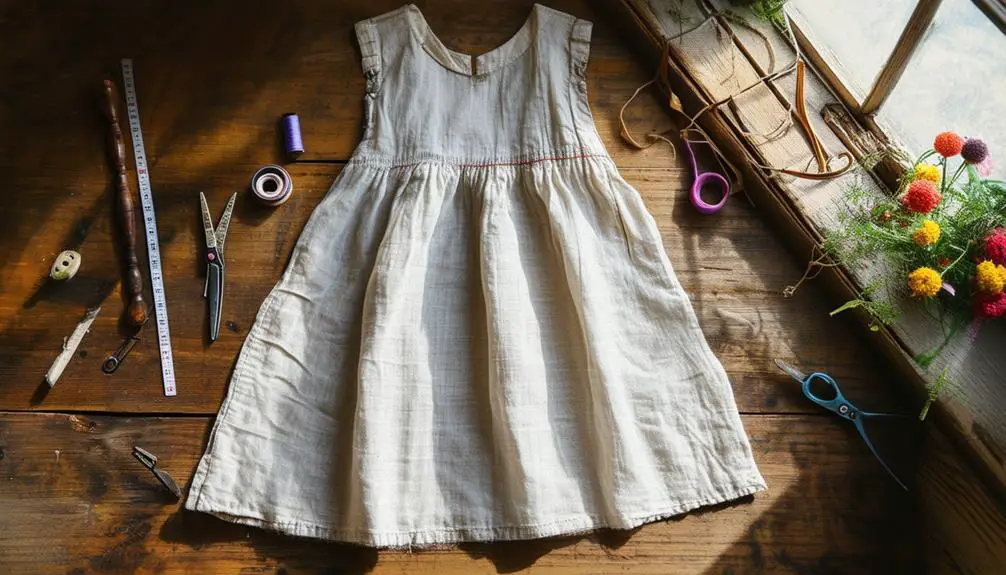When you think about Aretha Franklin, her powerful voice often comes to mind, but her fashion choices are just as significant. You can't overlook how her style evolved alongside her music, from the sophisticated looks of the 1960s to the bold, extravagant ensembles in the decades that followed. Each outfit not only enhanced her stage presence but also made statements about her identity and cultural significance. As you consider her most memorable pieces, it becomes clear that her fashion was more than just clothing—it was a reflection of her life and legacy. What do these choices reveal about her influence?
Early Career and Style Evolution
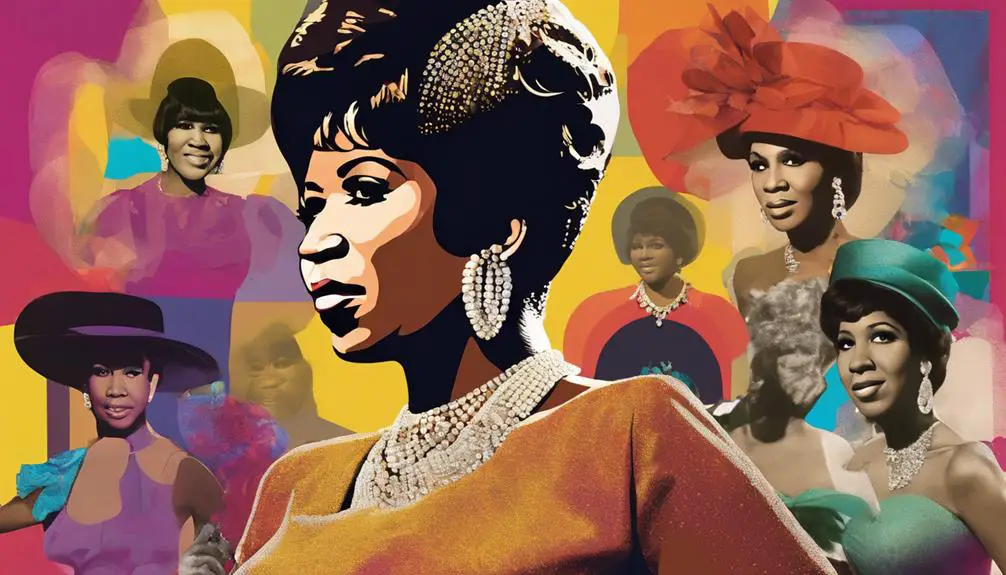
Aretha Franklin's rise to fame in the 1960s was more than just a musical journey; it marked the beginning of her iconic fashion evolution. Starting her career in a Detroit choir, she showcased her remarkable talent through gospel music, which laid the foundation for her distinct style. In those early days, you'd see her in a cream pencil dress with a knee-high split, a stunning choice that truly exemplified the glamour of the era.
As the 1970s rolled in, Aretha embraced more vibrant and dramatic fashion choices, often donning embellished gowns that mirrored her powerful stage presence. Her style wasn't just about looking good; it was a form of empowerment that resonated with her audience.
By the 1980s, she was stepping out in bold colors and extravagant designs, like that unforgettable strapless sequined gown at the 10th Annual Music Awards in 1983.
Throughout her career, Aretha Franklin's fashion choices reflected not only her artistry but also a deep sense of cultural pride. This evolution solidified her status as a true style icon, inspiring countless fans and artists alike who sought to channel her spirit and glamour.
Iconic Outfits Through the Decades
Throughout her career, Franklin's outfits became as legendary as her music, each decade showcasing her evolution as a fashion icon.
In the 1960s, you'd often see her in a cream pencil dress with a knee-high split, a perfect reflection of her glamorous style and undeniable fashion presence.
As the 1970s rolled in, she captured hearts in a stunning gold-embroidered gown while proudly holding a Grammy Award, a moment that highlighted not just her musical achievements but her exquisite taste in fashion.
The 1980s brought a bold and vibrant style, exemplified when she dazzled in a strapless sequined gown at the 10th Annual Music Awards, proving that she wasn't just the Queen of Soul but also a trendsetter.
In later years, Franklin captivated audiences in a regal gown by Arnold Scaasi during a 1990 performance, further solidifying her status as a fashion icon.
Even into the 2000s, her appearance in a cream dress paired with a luxurious brown fur coat at the 39th Annual Grammy Awards showcased her elegance and continued influence in the fashion world, leaving a lasting legacy of Aretha Franklin's most iconic outfits.
Memorable Performances and Fashion
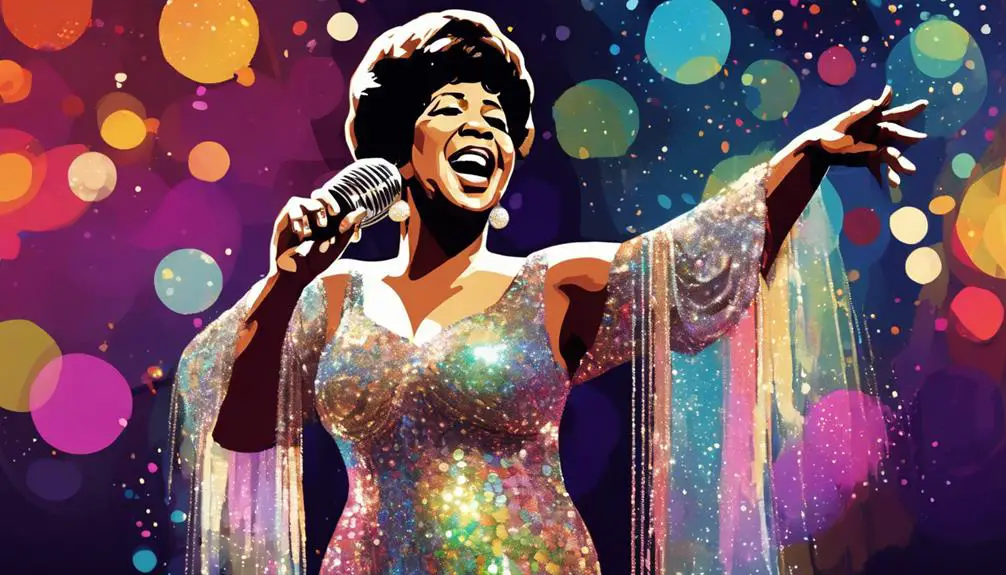
Often mesmerizing audiences with her performances, Franklin's fashion choices were just as unforgettable. Take, for instance, her standout performance in a powder blue gown circa 1985, where her powerful voice and elegant style captivated everyone in attendance.
Then, at Barack Obama's inauguration in 2009, she made waves in a striking gray hat adorned with rhinestones, becoming an iconic symbol of that historic moment.
Franklin didn't shy away from bold fashion statements. In 1973, she wowed the crowd in a purple bell-sleeve outfit that beautifully highlighted her connection to both music and fashion. Each performance was an opportunity for her to showcase her glamorous side.
Remember the 1970s when she dazzled the audience in a gold-embroidered gown while holding a Grammy Award? That image is forever etched in our minds, symbolizing her status as a music icon.
During the 10th Annual Music Awards in 1983, she once again turned heads in a strapless sequined gown, exemplifying her flair for dramatic and stunning outfits.
Aretha Franklin truly defined what it means to blend unforgettable music with equally memorable fashion moments.
Lasting Impact on Music and Fashion
With her dazzling gowns and bold hats, Aretha Franklin not only carved out her identity as the Queen of Soul but also left an indelible mark on both music and fashion. Her iconic fashion choices, from feathered gowns to luxurious furs, challenged societal norms and inspired countless artists to embrace self-expression through their unique styles.
Franklin's unforgettable performance at Barack Obama's inauguration, adorned in her striking grey felt hat, exemplified the powerful intersection of music, culture, and fashion in American history.
As the first woman inducted into the Rock and Roll Hall of Fame in 1987, Aretha Franklin solidified her role as a pioneer for Black women in the industry, showcasing the importance of representation. The vibrant colors and unique designs in her outfits reflected her cultural heritage, setting trends that resonate with audiences even today.
Her bold hats and glamorous ensembles became symbols of empowerment, encouraging artists to express themselves authentically. Aretha's influence continues to thrive, reminding us that fashion and music are intertwined, and that self-expression is an essential part of artistry.
Through her remarkable legacy, she's inspired generations to celebrate their individuality, both onstage and off.
Signature Hats and Cultural Significance
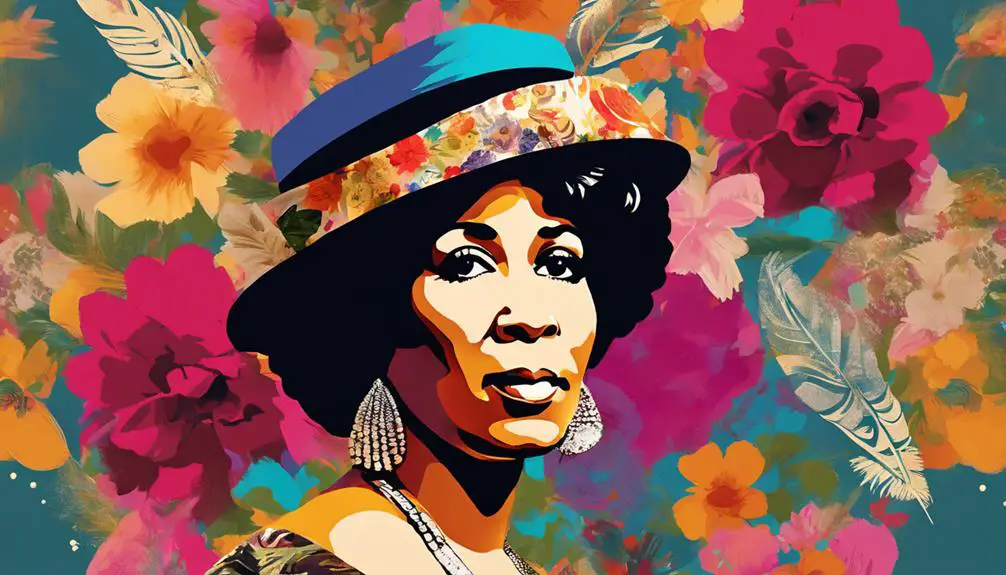
Aretha Franklin's signature hats are more than just fashion accessories; they embody the cultural significance and strength of Black women. Franklin often wore iconic hats that served as powerful symbols of Black women's culture, reflecting her roots in gospel music and her dynamic public image.
One standout moment was the bow-tied hat she wore at Barack Obama's inauguration in 2009, crafted in grey with rhinestones—a lasting emblem of that historic event.
Her church lady hat style exemplified the strength and resilience of Black women, frequently showcased during her gospel performances and public appearances. Franklin's preference for vibrant colors and unique designs transformed her hats into bold fashion statements, enhancing her stage presence and impacting trends in music and fashion alike.
These hats not only captured her personal style but also connected deeply to her cultural heritage, fostering pride and a sense of belonging within the Black community.
Frequently Asked Questions
What Kind of Clothes Did Aretha Franklin Wear?
Aretha Franklin wore gowns exuding elegance, colorful dresses showcasing vintage flair, and sequined outfits that dazzled. She complemented her glamorous stagewear with bold accessories and statement hats, reflecting cultural significance and her timeless, tailored suits.
What Was Aretha Franklin's Style?
When you think of style, imagine glamorous gowns draping like whispers of elegance. Bold colors sing, while elegant accessories and statement hats dance around vintage charm—creating chic ensembles with powerful silhouettes that echo cultural significance and timeless elegance.
Why Is Aretha Franklin Iconic?
Aretha Franklin's iconic status stems from her as a Queen Diva and Soul Legend, blending gospel roots with bold statements. As a Fashion Pioneer and Cultural Icon, she symbolizes empowerment through music and timeless elegance, inspiring generations.
What Influence Did Aretha Franklin Have?
Aretha Franklin's influence shaped soul music and highlighted cultural impact, serving as a feminist icon. Her gospel roots fueled her vocal prowess, while her artistic expression in fashion evolved, leaving a lasting musical legacy during the civil rights movement.
